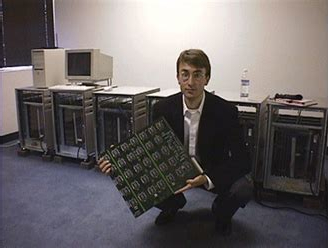|
RSA Secret-Key Challenge
The RSA Secret-Key Challenge was a series of cryptographic contests organised by RSA Laboratories with the intent of helping to demonstrate the relative security of different encryption algorithms. The challenge ran from 28 January 1997 until May 2007. Contest details For each contest, RSA had posted on its website a block of ciphertext and the random initialization vector used for encryption. To win, a contestant would have had to break the code by finding the original plaintext and the cryptographic key that will generate the posted ciphertext from the plaintext. The challenge consisted of one DES contest and twelve contests based around the block cipher RC5. Each of the RC5 contests is named after the variant of the RC5 cipher used. The name ''RC5-w/r/b'' indicates that the cipher used ''w''-bit words, ''r'' rounds, and a key made up of ''b'' bytes. The contests are often referred to by the names of the corresponding distributed.net projects, for example RC5-32/12/9 is of ... [...More Info...] [...Related Items...] OR: [Wikipedia] [Google] [Baidu] |
Cryptographic
Cryptography, or cryptology (from grc, , translit=kryptós "hidden, secret"; and ''graphein'', "to write", or '' -logia'', "study", respectively), is the practice and study of techniques for secure communication in the presence of adversarial behavior. More generally, cryptography is about constructing and analyzing protocols that prevent third parties or the public from reading private messages. Modern cryptography exists at the intersection of the disciplines of mathematics, computer science, information security, electrical engineering, digital signal processing, physics, and others. Core concepts related to information security ( data confidentiality, data integrity, authentication, and non-repudiation) are also central to cryptography. Practical applications of cryptography include electronic commerce, chip-based payment cards, digital currencies, computer passwords, and military communications. Cryptography prior to the modern age was effectively synonymous wi ... [...More Info...] [...Related Items...] OR: [Wikipedia] [Google] [Baidu] |
RSA Laboratories
RSA Security LLC, formerly RSA Security, Inc. and doing business as RSA, is an American computer and network security company with a focus on encryption and encryption standards. RSA was named after the initials of its co-founders, Ron Rivest, Adi Shamir and Leonard Adleman, after whom the RSA public key cryptography algorithm was also named. Among its products is the SecurID authentication token. The BSAFE cryptography libraries were also initially owned by RSA. RSA is known for incorporating backdoors developed by the NSA in its products. It also organizes the annual RSA Conference, an information security conference. Founded as an independent company in 1982, RSA Security was acquired by EMC Corporation in 2006 for US$2.1 billion and operated as a division within EMC. When EMC was acquired by Dell Technologies in 2016, RSA became part of the Dell Technologies family of brands. On 10 March 2020, Dell Technologies announced that they will be selling RSA Security to a consort ... [...More Info...] [...Related Items...] OR: [Wikipedia] [Google] [Baidu] |
Encryption Algorithm
In cryptography, encryption is the process of encoding information. This process converts the original representation of the information, known as plaintext, into an alternative form known as ciphertext. Ideally, only authorized parties can decipher a ciphertext back to plaintext and access the original information. Encryption does not itself prevent interference but denies the intelligible content to a would-be interceptor. For technical reasons, an encryption scheme usually uses a pseudo-random encryption key generated by an algorithm. It is possible to decrypt the message without possessing the key but, for a well-designed encryption scheme, considerable computational resources and skills are required. An authorized recipient can easily decrypt the message with the key provided by the originator to recipients but not to unauthorized users. Historically, various forms of encryption have been used to aid in cryptography. Early encryption techniques were often used in military ... [...More Info...] [...Related Items...] OR: [Wikipedia] [Google] [Baidu] |
Initialization Vector
In cryptography, an initialization vector (IV) or starting variable (SV) is an input to a cryptographic primitive being used to provide the initial state. The IV is typically required to be random or pseudorandom, but sometimes an IV only needs to be unpredictable or unique. Randomization is crucial for some encryption schemes to achieve semantic security, a property whereby repeated usage of the scheme under the same key does not allow an attacker to infer relationships between (potentially similar) segments of the encrypted message. For block ciphers, the use of an IV is described by the modes of operation. Some cryptographic primitives require the IV only to be non-repeating, and the required randomness is derived internally. In this case, the IV is commonly called a nonce (a number used only once), and the primitives (e.g. CBC) are considered ''stateful'' rather than ''randomized''. This is because an IV need not be explicitly forwarded to a recipient but may be derived fro ... [...More Info...] [...Related Items...] OR: [Wikipedia] [Google] [Baidu] |
Cryptographic Key
A key in cryptography is a piece of information, usually a string of numbers or letters that are stored in a file, which, when processed through a cryptographic algorithm, can encode or decode cryptographic data. Based on the used method, the key can be different sizes and varieties, but in all cases, the strength of the encryption relies on the security of the key being maintained. A key’s security strength is dependent on its algorithm, the size of the key, the generation of the key, and the process of key exchange. Scope The key is what is used to encrypt data from plaintext to ciphertext. There are different methods for utilizing keys and encryption. Symmetric cryptography Symmetric cryptography refers to the practice of the same key being used for both encryption and decryption. Asymmetric cryptography Asymmetric cryptography has separate keys for encrypting and decrypting. These keys are known as the public and private keys, respectively. Purpose Since the key pro ... [...More Info...] [...Related Items...] OR: [Wikipedia] [Google] [Baidu] |
Data Encryption Standard
The Data Encryption Standard (DES ) is a symmetric-key algorithm for the encryption of digital data. Although its short key length of 56 bits makes it too insecure for modern applications, it has been highly influential in the advancement of cryptography. Developed in the early 1970s at IBM and based on an earlier design by Horst Feistel, the algorithm was submitted to the National Bureau of Standards (NBS) following the agency's invitation to propose a candidate for the protection of sensitive, unclassified electronic government data. In 1976, after consultation with the National Security Agency (NSA), the NBS selected a slightly modified version (strengthened against differential cryptanalysis, but weakened against brute-force attacks), which was published as an official Federal Information Processing Standard (FIPS) for the United States in 1977. The publication of an NSA-approved encryption standard led to its quick international adoption and widespread academic scrutiny. ... [...More Info...] [...Related Items...] OR: [Wikipedia] [Google] [Baidu] |
DES Challenges
The DES Challenges were a series of brute force attack contests created by RSA Security to highlight the lack of security provided by the Data Encryption Standard. The Contests The first challenge began in 1997 and was solved in 96 days by the DESCHALL Project. DES Challenge II-1 was solved by distributed.net in 39 days in early 1998. The plaintext message being solved for was "The secret message is: Many hands make light work." DES Challenge II-2 was solved in just 56 hours in July 1998, by the Electronic Frontier Foundation (EFF), with their purpose-built Deep Crack machine. EFF won $10,000 for their success, although their machine cost $250,000 to build. The contest demonstrated how quickly a rich corporation or government agency, having built a similar machine, could decrypt ciphertext encrypted with DES. The text was revealed to be "The secret message is: It's time for those 128-, 192-, and 256-bit keys." DES Challenge III was a joint effort between distributed.net and Dee ... [...More Info...] [...Related Items...] OR: [Wikipedia] [Google] [Baidu] |
Electronic Frontier Foundation
The Electronic Frontier Foundation (EFF) is an international non-profit digital rights group based in San Francisco, California. The foundation was formed on 10 July 1990 by John Gilmore, John Perry Barlow and Mitch Kapor to promote Internet civil liberties. The EFF provides funds for legal defense in court, presents '' amicus curiae'' briefs, defends individuals and new technologies from what it considers abusive legal threats, works to expose government malfeasance, provides guidance to the government and courts, organizes political action and mass mailings, supports some new technologies which it believes preserve personal freedoms and online civil liberties, maintains a database and web sites of related news and information, monitors and challenges potential legislation that it believes would infringe on personal liberties and fair use and solicits a list of what it considers abusive patents with intentions to defeat those that it considers without merit. History Fou ... [...More Info...] [...Related Items...] OR: [Wikipedia] [Google] [Baidu] |
EFF DES Cracker
In cryptography, the EFF DES cracker (nicknamed "Deep Crack") is a machine built by the Electronic Frontier Foundation (EFF) in 1998, to perform a brute force search of the Data Encryption Standard (DES) cipher's key space – that is, to decrypt an encrypted message by trying every possible key. The aim in doing this was to prove that the key size of DES was not sufficient to be secure. Background DES uses a 56-bit key, meaning that there are 256 possible keys under which a message can be encrypted. This is exactly 72,057,594,037,927,936, or approximately 72 quadrillion possible keys. One of the major criticisms of DES, when proposed in 1975, was that the key size was too short. Martin Hellman and Whitfield Diffie of Stanford University estimated that a machine fast enough to test that many keys in a day would have cost about $20 million in 1976, an affordable sum to national intelligence agencies such as the US National Security Agency. Subsequent advances in the price/perf ... [...More Info...] [...Related Items...] OR: [Wikipedia] [Google] [Baidu] |
Distributed
Distribution may refer to: Mathematics *Distribution (mathematics), generalized functions used to formulate solutions of partial differential equations *Probability distribution, the probability of a particular value or value range of a variable **Cumulative distribution function, in which the probability of being no greater than a particular value is a function of that value *Frequency distribution, a list of the values recorded in a sample *Inner distribution, and outer distribution, in coding theory *Distribution (differential geometry), a subset of the tangent bundle of a manifold *Distributed parameter system, systems that have an infinite-dimensional state-space *Distribution of terms, a situation in which all members of a category are accounted for *Distributivity, a property of binary operations that generalises the distributive law from elementary algebra * Distribution (number theory) *Distribution problems, a common type of problems in combinatorics where the goal i ... [...More Info...] [...Related Items...] OR: [Wikipedia] [Google] [Baidu] |
Distributed Computing
A distributed system is a system whose components are located on different computer network, networked computers, which communicate and coordinate their actions by message passing, passing messages to one another from any system. Distributed computing is a field of computer science that studies distributed systems. The components of a distributed system interact with one another in order to achieve a common goal. Three significant challenges of distributed systems are: maintaining concurrency of components, overcoming the clock synchronization, lack of a global clock, and managing the independent failure of components. When a component of one system fails, the entire system does not fail. Examples of distributed systems vary from service-oriented architecture, SOA-based systems to massively multiplayer online games to peer-to-peer, peer-to-peer applications. A computer program that runs within a distributed system is called a distributed program, and ''distributed programming' ... [...More Info...] [...Related Items...] OR: [Wikipedia] [Google] [Baidu] |
Brute Force Attack
In cryptography, a brute-force attack consists of an attacker submitting many passwords or passphrases with the hope of eventually guessing correctly. The attacker systematically checks all possible passwords and passphrases until the correct one is found. Alternatively, the attacker can attempt to guess the key which is typically created from the password using a key derivation function. This is known as an exhaustive key search. A brute-force attack is a cryptanalytic attack that can, in theory, be used to attempt to decrypt any encrypted data (except for data encrypted in an information-theoretically secure manner). Such an attack might be used when it is not possible to take advantage of other weaknesses in an encryption system (if any exist) that would make the task easier. When password-guessing, this method is very fast when used to check all short passwords, but for longer passwords other methods such as the dictionary attack are used because a brute-force search ... [...More Info...] [...Related Items...] OR: [Wikipedia] [Google] [Baidu] |




